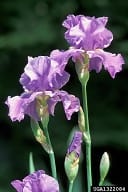
Mark Czarnota, Ph.D., Ornamental Weed Control Specialist
This is an excerpt from a longer publication found here
Weed control in irises can be difficult. Fortunately, many annual broadleaf and grassy weeds can be easily controlled with mulches and the judicious use of herbicides.
Mulch is helpful in preventing weed growth, but it should be used sparingly (no greater than a 2-inch layer in irises) to avoid disease problems.
The preemergent herbicides in the following table are labeled to control a large spectrum of broadleaf and grass weeds in irises.
| TRADE NAMES | ACTIVE INGREDIENT |
| Barricade and RegalKade (Granular) | prodiamine |
| Dimension | dithiopyr |
| Gallery | isoxaben |
| Freehand | dimethenamid and pendimethalin |
| Pendulum, Corral (Granular) | pendimethalin |
| Pennant | metolachlor |
| Snapshot (Granular) | isoxaben and trifluralin |
| Surflan | oryzalin |
| Treflan and Preen | trifluralin |
| XL (Amaze) | benefin and oryzalin |
- Most preemergence herbicides listed are available in both a granular and sprayable form. Granular herbicides are popular because they require no mixing and are more forgiving when an application error is made.
- Most herbicides or herbicide combinations will control 80 to 95 percent of the annual weeds normally found in irises. Many weeds not controlled with preemergent herbicides can be removed by hand.
- The herbicides listed are designed to control weeds germinating from seed not weeds coming from vegetative structures (tubers, rhizomes, etc.).
- During iris establishment, and under heavy weed infestation, at least two herbicide applications should be made in most Southern states — usually in January / February and again in April /May — to control most spring and summer weeds.
- Additional preemergence herbicide applications may be necessary to control annual winter weeds. Preemergence herbicides tend to be more useful on large acreages.
Several postemergence grass herbicides are labeled for use in irises.
| TRADE NAMES | ACTIVE INGREDIENT |
| Acclaim Extra | fenoxaprop |
| Envoy Plus | clethodim |
| Fusilade II, Ornamec, and Grass-B-Gon | fluazifop |
| Segment | sethoxydim |
- Postemergence grass herbicides are mixed with water and sprayed over the top of irises to control grasses that are actively growing.
- These grass herbicides have no preemergent activity and will not prevent the germination of weed seeds.
- Herbicide labeling can change, so always read and understand the label before using any pesticide.
- As herbicides go off patent, some manufacturers market herbicides under different trade names, so the buyer must beware. For instance, glyphosate, the active ingredient in Roundup®, is now available from many suppliers under a wide range of trade names and formulations.
Herbicides containing the active ingredient glyphosate can be used to control problem perennial weeds that are unsuccessfully controlled by hand removal or mulches. Weeds growing among irises should first be carefully separated from iris leaves and then placed horizontally on bare ground or a piece of plastic for treatment. Next, paint or sponge a 5 percent solution of glyphosate (6 ounces of at least a 41 percent glyphosate concentrate per 128 ounces of water). A cover, such as a plastic bag, placed over the iris plant while treating the weeds will help shield the iris from the herbicide. Remove protective coverings once the herbicide has dried. The treated weeds will begin to die in 10 to 14 days. If weeds re-sprout, repeat the treatment procedure.
Broadleaf and other perennial weeds can be difficult to control in iris. Nutsedge (Cyperus spp.) and Florida betony (Stachys floridana), for instance, are two problem weeds with no labeled selective herbicides available to control them in iris.
The University of Georgia has conducted experiments with both 2,4-D (various trade names) for controlling select broadleaf weeds and halosulfuron (Sedgehammer® and Prosedge®) for controlling nutsedge. Neither product is labeled for weed control in Iris, but data has indicated labeled rates of these postemergence herbicides can be used on select Iris cultivars with little to no damage. It is suggested that users wishing to try this method test it on small areas of iris / weeds to be treated. Wait two weeks and then evaluate the iris plants for unacceptable damage before treating an entire area.
Always read the product label and contact your local County Extension office with any pesticide or plant culture questions.
For more information see Dr Czarnota’s entire publication found here
